Creating the right culture is essential to any company’s success. The key pillars of a successful sales culture include a clearly articulated mission and revenue goals, the use of science-based methods, organizational trust, and ongoing sales coaching.
The Importance of Culture
The sales culture of a company will be a key factor in determining whether a business is successful or not. Every company generates a unique sales culture that reflects its customers, its founders, and the business itself, however, most high-performing sales teams typically share four cultural pillars that have helped them achieve success.
In order to build a winning company strategy from day one, begin by putting customer-centric principles and team success at the core of your sales culture. To do this, you must clearly define the company-wide goals, vision, and values that everyone will be accountable for upholding. Being part of a bigger purpose will motivate employees to strive for excellence, and it also aligns the company on shared beliefs. This type of cultural accountability will prove its value during a company’s most challenging quarters as it brings everyone together to work harder in order to meet (or exceed) company goals.
Key Pillars of a Successful Sales Culture
There are four key pillars of culture that most successful sales organizations have in common. Adopt each of the following to realize a successful sales culture for your team:
- Clearly articulated company mission and revenue goals
- Science-based methods
- Strong organizational trust at all levels
- Objective coaching delivered to the team
Company Mission and Revenue Goals
Begin by defining your company mission. Having a clear understanding of your organization’s “why” is one of the key building blocks of your unique sales culture. This enables your company to hire the right candidates, shape customer engagements, and manage performance in a manner that aligns with your company values. For a primer on this topic, listen to the TED Talk by Simon Sinek entitled “How Great Leaders Inspire Action.”
Be deliberate. Write down your company’s “why” and clearly communicate it to your sales team and any candidates that you are recruiting. Once you have the “why” in place, you must also articulate company sales goals and objectives that clearly align with your “why.” A high-performing sales team will tie their daily efforts to these goals. Because sales is a difficult role that requires significant persistence in the face of rejection, tethering daily sales efforts to broader organizational objectives is key to creating a culture of learning and success.
Science-Backed Decision-Making Methods
To create a successful company culture, you should also adopt science-backed methods and processes to use when making decisions. In sales, “superstar culture” is often the antithesis of science-based culture. Superstar culture relies on high-achieving individual contributors to win big deals. Typically, these so-called superstars use enterprise-level sales skills developed and fine-tuned over many years of experience.
Science-based culture, however, necessitates the need for specific numbers and processes that are backed by science. Companies that embrace a science-based culture will identify target sales goals and then reverse engineer their sales processes to find the leading metrics that will result in reaching those goals. In some instances, there will be new roles and no clear path that determines the exact “math” for success, but using industry best practices, you can usually create a benchmark to work toward and refine from there. See Table A for an example of how to do this.
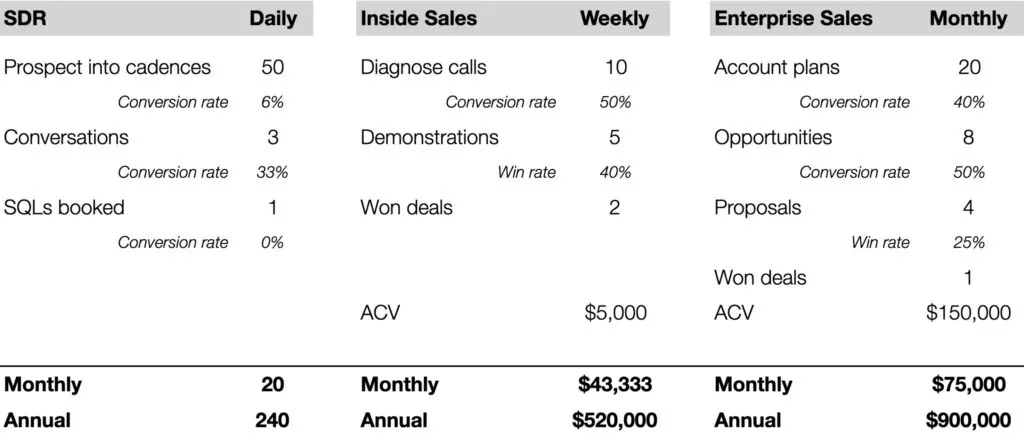
Table A. Assigning goals to each key metric in order to attain overall team goal
Organizational Trust at All Levels
A strong sales culture cannot be built by a single individual, manager, or founder. The entire team must commit to continuous learning and agile approaches in order to scale. This type of commitment will require building organizational trust. The keys to creating that organizational trust are as follows:
- Building shared accountability: Encourage individuals and teams to hold themselves accountable for their own actions. You will find that this becomes much more natural for teams when they see their leaders doing this as well.
- Displaying high emotional intelligence: Although your team is engaging in a business environment, they are still human, so you must take this into account with all company-wide interactions. Each person deals with challenges and opportunities differently, so take the time to understand your team and support everyone’s individual approaches.
- Supporting individual growth and success: The organization and the individuals should be on a journey of continuous improvement. For the team, this means creating shared learning opportunities. For the individual, this means spending one-on-one time with team members to understand their personal motivations, what they want to gain from their roles, and which skills they will need to progress their careers.
Ongoing, Objective Coaching
Sales managers and sales leaders often refer to themselves as sales experts who manage teams. Managing people, however, is an outdated approach to leadership. Instead, they should be coaching their team members.
Companies with a successful sales culture deliver objective coaching to their teams on an ongoing basis. To do this, you must develop a collaborative learning environment that continually evolves in order to help your sales team grow and improve through coaching. To put this coaching process into place, use the 70-20-10 principle detailed in Table B.
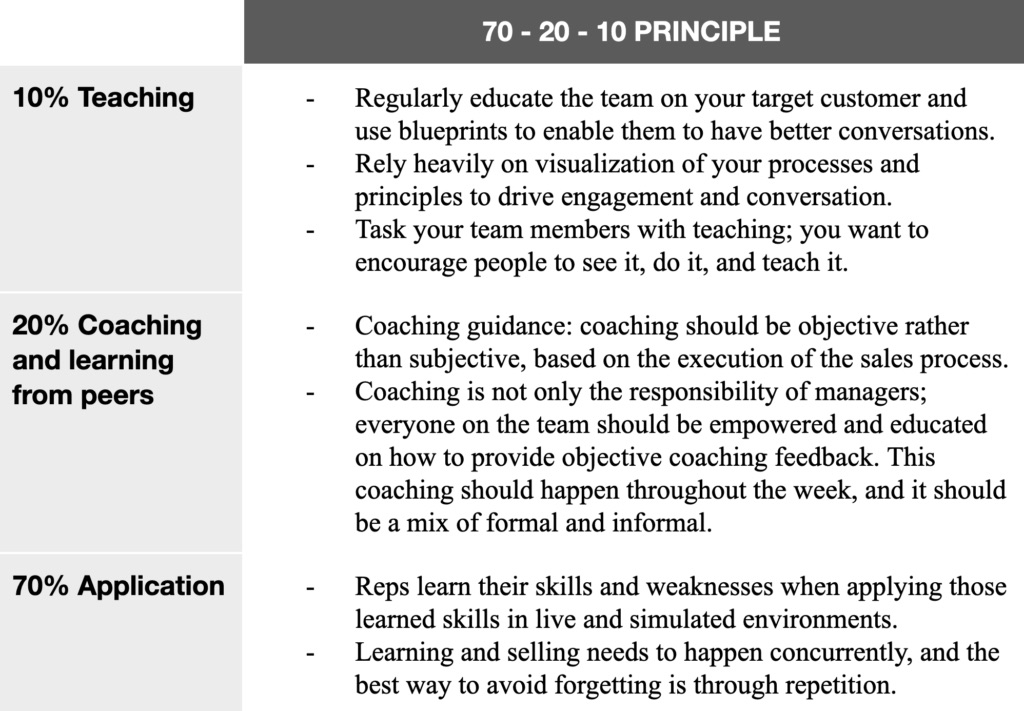
Table B. The 70-20-10 principle for managing coaching time
Performance Management
When managing sales team performance and conducting reviews, consider implementing the following best practices:
- Weekly one-on-one pipeline reviews between team members using a set format to discuss accounts.
- Rather than simply talking through the details of an account, try to help team members solve roadblocks.
- Institute a group call review. Teams should review a minimum of two calls at the end of each week.
As you are focused on performance management, remember that the most common mistakes that sales reps make are as follows:
- Having only one contact or relationship with the account
- Failing to do the basic “blocking and tackling” in accordance with the sales process
- Trying to do things themselves instead of asking for help from their manager (usually account executives)
As you attempt to improve overall sales management and culture, consider the following common mistakes made by sales managers during pipeline reviews and day-to-day management duties:
- Directing sales reps on what to change about their behavior but failing to provide coaching on how to change it.
- Lacking the full process. Because most problems are related to process rather than people, managers need to have the right processes in place for sales reps to learn and practice good sales pipeline maintenance. (For example: What are the top five critical events you sell against? What impact are you creating for your customers? What are the use cases for different customers?)
- Keeping coaching to themselves. Coaching should be owned by the team rather than managers alone. Senior reps should be coaching junior reps. Those sales reps who have closed a certain type of deal in the past should be coaching other reps on those deals. Managers should have the entire team take ownership of coaching and elevating each other’s skills.
Roles and Responsibilities
Sales managers will not have the bandwidth to micromanage the sales process for all of their sales reps, nor should they have to. Rather than manage the whole sales process, they should focus on key moments that matter within the process to make a difference.
As for account executives (AEs), the work that your AE does will depend largely on your company’s Average Contract Value (ACV). In platform sales, the AE should do his or her own prospecting work rather than having a Sales Development Rep (SDR) prospect and then hand over leads to the AE. In contrast, for high-velocity application sales (below ~$15k ACV), you should use a multi-role sales organization in which the SDR prospects and sets meetings for the AE. See Table C for a distribution of responsibility based on ACV.

Table C. Prospecting roles based on your ACV
Common Pitfalls in Performance Management
Pitfall 1: Improper handoffs. It is crucial to ensure that each different sales role executes a smooth handoff (e.g., from AE to CSM/ONB when a new customer is onboarding). These are important moments to the customer as they will want to know that everyone in your organization is coordinating to help them.
Pitfall 2: Reaching out to prospects who are a fit based on key demographics. Qualifying prospects based on key demographics (e.g., title, location, etc.) will send your company into overdrive, but this is often very ineffective. This pitfall indicates that you are targeting by using inefficient “fit” characteristics and failing to identify customers who actually have a “pain.”
Pitfall 3: Treating the kickoff call for new customers as onboarding. When a lead has committed to your company and becomes a paying customer, the kickoff call becomes a very important moment. This is not simply a call to get them onboarded with your product, though many salespeople may treat it that way. This is the point at which your relationship with the customer has changed, and you now have the shared goal of making them successful. At this moment, you are setting the tone for your ongoing relationship.
How to Structure Coaching Conversations
Step 1: Identify the meetings your company needs to conduct. Decide which types of meetings you need to conduct with your team and determine how often you need to conduct them. See Table D for guidance on meeting frequency and who should participate in each.

Table D. Frequency of meetings – daily (d), weekly (w), monthly (m), or quarterly (q)
Step 2: Set expectations for each meeting. Help your team understand the expectations, discussions, and goals for each type of session. Use Table E for guidance.
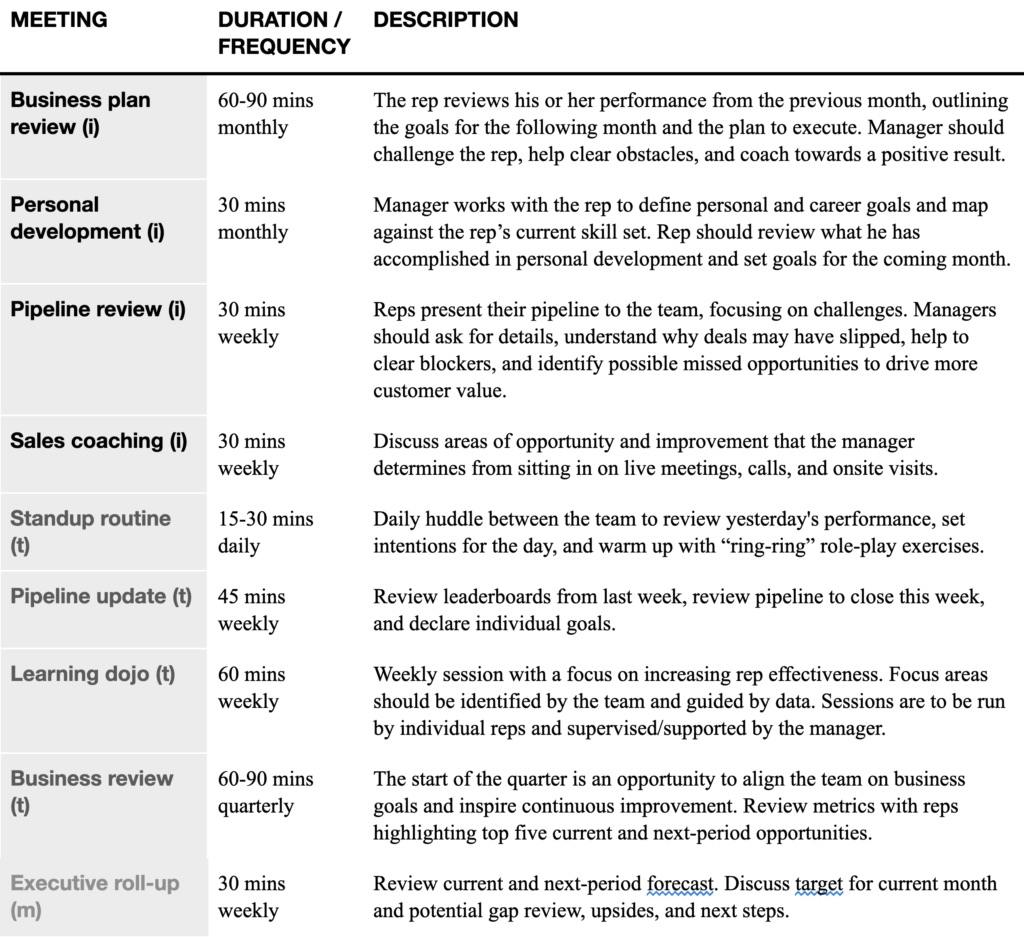
Table E. Descriptions, duration, and frequency of coaching meetings – individual (i), team (t), managing up (m)
Step 3: Schedule your cadences for the week. While it might seem obvious, do not schedule coaching meetings during ideal selling time. Take into account when your customers are available for meetings and when your team will be most productive before scheduling team meetings. Every sales team will settle into their own slightly different cadence, but Figure 1 provides an example of a schedule for recurring meetings.

Figure 1. A sample cadence of weekly recurring meetings
Step 4: Schedule your quarterly plan. Using the same guidelines as above, create a quarterly plan by mapping out a cadence of your monthly and quarterly meetings. See Figure 2 as an example.

Figure 2. A sample quarterly plan with cadences across each week for individual, team, and executive meetings
Step 5: Create a sales coaching calendar. Set objectives, training topics, and themes for each of your coaching sessions. Refer to Table F for a sample calendar. that provides potential sales topics and themes for discussion during meetings.
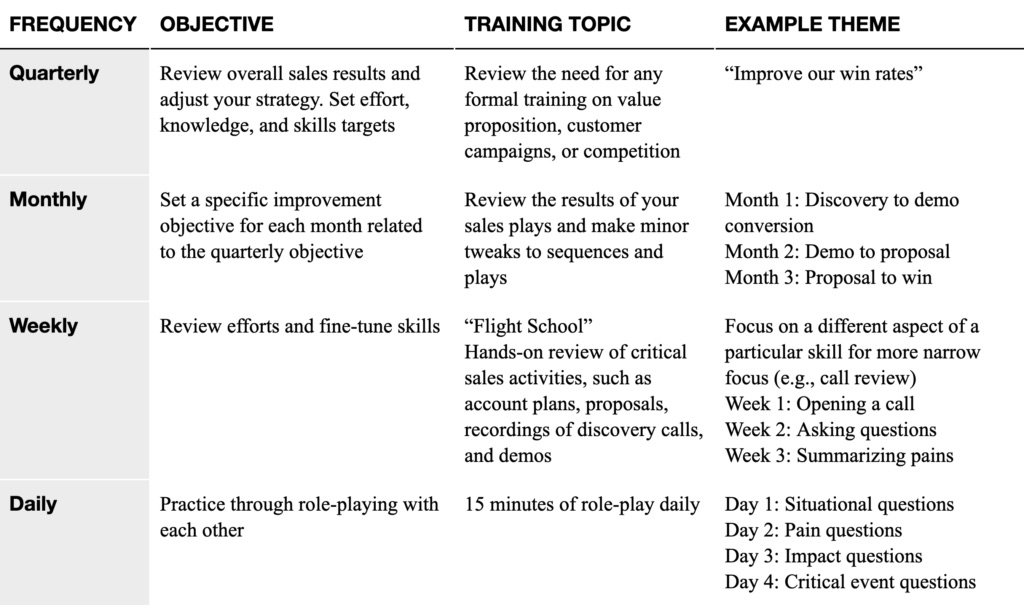
Table F. A sample coaching calendar
Step 6: Communicate with your team. To ensure success as you implement this coaching strategy, set the vision for what your team will be able to accomplish as a result of this schedule and rigor. If you frame coaching as a collection of meetings, it will not sound interesting or valuable. However, when you explain how these sessions will help the team (e.g. improve individual skills, give them a better chance to meet goals, increase team efficiency and effectiveness), this will motivate people to get involved and participate more fully.

Figure 3. The four brain chemicals that drive behavior
Hiring a Sales Leader
Culture comes from the entire team, but it is your sales leader who will set the tone for the organization. Simon Sinek’s presentation “Why Leaders Eat Last” provides a great outline for a modern sales leadership culture. This modern sales culture is based on four chemicals that occur in the brain, as depicted in Figure 3 and explained more fully in Table G.
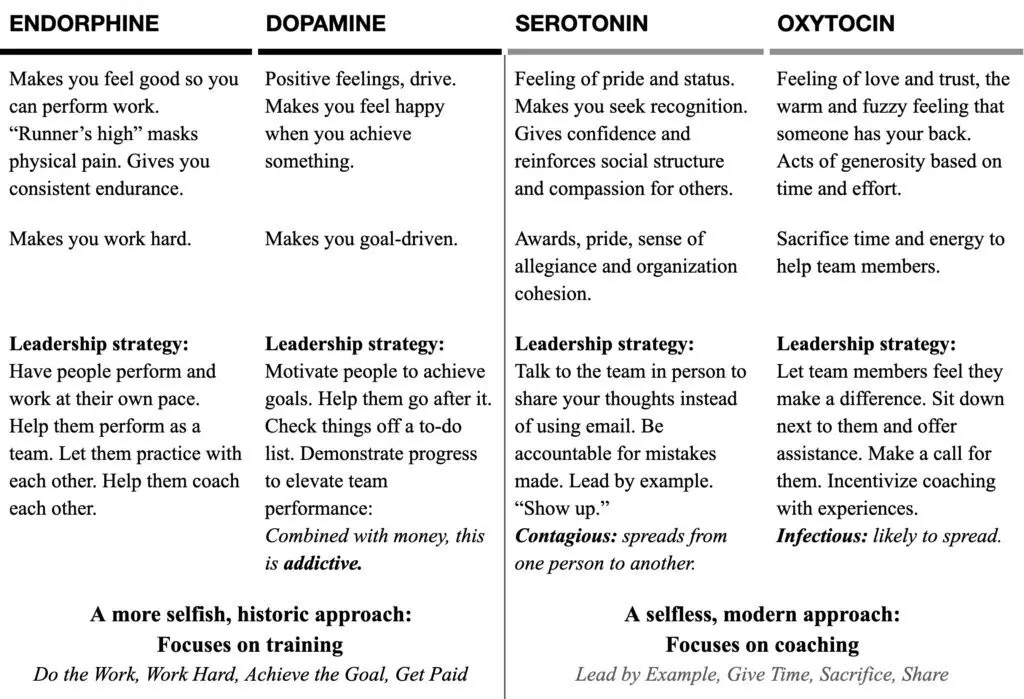
Table G. A new kind of leadership
When hiring a sales leader, look for a candidate with the selfless, modern approach detailed on the right side of Figure 4. Choose someone who will be a coach for your sales team, not someone who simply works hard. The following list includes specific ways that this modern, selfless mindset will manifest itself in a leader’s behavior:
- Motivating the team to work hard
- Helping the team to achieve goals through shared work
- Leading by example; not a “desk jockey” or a spreadsheet manager
- Actively developing and sharing best practices and encouraging others to share as well
- Helping team members elevate their skills by coaching rather than simply fixing
- Driving the team to operate in a way that is greater than the sum of its individual members
Because there is so much that goes into hiring a VP of Sales, some organizations take more than a year to find the right person. Be sure to work with your board and advisors to agree on the specific qualities and skills that your team needs. This will make the search process faster and more effective.
Guidance on Setting a Culture
Many companies consider seeking out a few high-performing “superstar” sales reps to see if a great culture will naturally develop. While this strategy may help a business reach $1M to $2M in Annual Recurring Revenue (ARR), it will likely stand in the way of achieving greater levels of sales and success. A business must plan for scale, and superstars do not scale.
Many company leaders believe they should craft a culture that is a reflection of themselves, however, this can be very tough on employees. They will not work as hard as a founder/CEO, nor will they be as motivated or as stressed. As a leader, you may put your personal stamp on the culture if you like, but the majority should come from your team.
Another quandary that many sales leaders face is whether or not to express opinions unrelated to the company (for example, political views) on social media. There are two opposing points of view, both of which are valid:
- You represent all people in your company. As such, you should never pick a side. This is the more politically correct and common leadership model. If you choose this route, focus 100% on the company when using social media, occasionally interspersing with personality posts.
- Your people look to you to represent them. As such, they want you to voice their opinion in a balanced and composed way. If you choose this route, stick to signaling a few core principles that directly relate to what is going on in your world.
This is a highly sensitive topic that you should discuss with your executive team because it can have positive or negative ramifications on hiring, tone, culture, etc. Do not simply go online and voice your emotions.
Common Pitfalls When Creating a Culture
Pitfall 1: Relying on a superstar sales culture. There is often a misconception that having “superstars” on the sales team will contribute to a winning culture. Interestingly, the overwhelming majority of sales teams rely on superstars to deliver 80% of their results, so it is easy to believe that the best way to grow and scale would be to hire as many superstars as possible. As mentioned above, this tactic may get a company to its first $1M or even $2M in ARR, but businesses with this type of sales culture will inevitably become dependent on a single performer.
In the beginning, these companies rely on the Founder/CEO who will train only sporadically (if at all) and incorporate little discipline and methodology into company operations. When this type of organization attempts to scale, the entire system breaks down because there is nothing in place (processes, training, etc.) to scale. Instead, successful, high-growth companies should transition to a process-based culture and then use technology to act as a force multiplier. They should incorporate enablement tools, skills, and finally, a team.
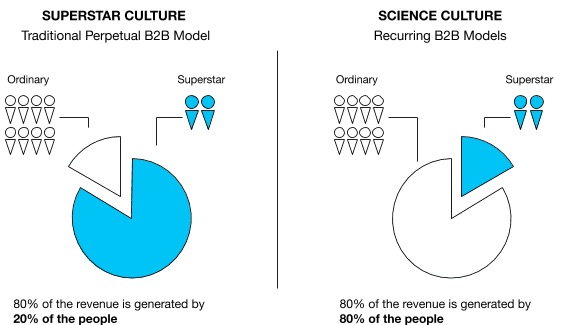
Figure 4. Superstar culture may get you to $2M, but you will need a science-based culture to scale beyond $2M
Pitfall 2: Hiring an “alpha” sales leader in a team culture. The alpha sales leader focuses on the individual more than the team. He or she will follow the general concept of “work hard, hit goal, get paid,” but you should look for someone who focuses on collaboration, helping each other, and shared success. The latter combination creates a sustainable sales culture in which team members feel supported and want to stay.
Pitfall 3: “Coffee machine startup culture.” Many startups design office spaces that look and feel like hip, high-end coffee houses. This will attract employees who place importance on that sort of comfortable, laid back environment (frequently those who enjoy spending 1.5 hours a day sipping lattes). Your office space should be welcoming, but do not go overboard because the appearance of the space can often manifest in your team culture.
Pitfall 4: No deep work space. The open floor plan is also very popular with companies today, but this design does not allow for true focus or “deep work.” People interrupt each other, the coffee machine is brewing, the TV might be on, and people are talking. While it may be trendy, no deep work happens in this sort of space. (Examples of deep work include researching a key account, writing a proposal, calculating a price, etc.) If your office is designed this way, consider designating a “library room” where employees can go for undisturbed deep work. This space would be analogous to a “no talking” area in a public library or the “quiet car” on a train.
Pitfall 5: Urgent vs. Important. Early-stage companies often struggle with recognizing the difference between tasks that are important versus those that are urgent. As an executive team, spend time classifying activities at a high level so that your team is aware of the difference and the order in which they should handle them. See Table H for examples of sales activities and how to prioritize based on importance versus urgency.

Table H. Priorities based on what is urgent versus what is important

